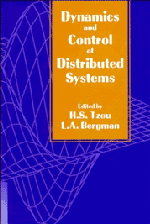Refine search
Actions for selected content:
1550 results in Control systems and optimization
10 - Tools for modeling, simulation, control, and verification of piecewise affine systems
- from Part II - Tools
-
-
- Book:
- Handbook of Hybrid Systems Control
- Published online:
- 21 February 2011
- Print publication:
- 15 October 2009, pp 297-324
-
- Chapter
- Export citation
Contents
-
- Book:
- Handbook of Hybrid Systems Control
- Published online:
- 21 February 2011
- Print publication:
- 15 October 2009, pp v-vi
-
- Chapter
- Export citation
15 - Automotive control
- from Part III - Applications
-
-
- Book:
- Handbook of Hybrid Systems Control
- Published online:
- 21 February 2011
- Print publication:
- 15 October 2009, pp 439-470
-
- Chapter
- Export citation
Part I - Theory
-
- Book:
- Handbook of Hybrid Systems Control
- Published online:
- 21 February 2011
- Print publication:
- 15 October 2009, pp 1-2
-
- Chapter
- Export citation
12 - Interchange formats and tool integration
- from Part II - Tools
-
-
- Book:
- Handbook of Hybrid Systems Control
- Published online:
- 21 February 2011
- Print publication:
- 15 October 2009, pp 361-374
-
- Chapter
- Export citation
7 - Stochastic hybrid systems
- from Part I - Theory
-
-
- Book:
- Handbook of Hybrid Systems Control
- Published online:
- 21 February 2011
- Print publication:
- 15 October 2009, pp 249-276
-
- Chapter
- Export citation
11 - Modeling, simulation, and optimization environments
- from Part II - Tools
-
-
- Book:
- Handbook of Hybrid Systems Control
- Published online:
- 21 February 2011
- Print publication:
- 15 October 2009, pp 325-360
-
- Chapter
- Export citation
13 - Energy management
- from Part III - Applications
-
-
- Book:
- Handbook of Hybrid Systems Control
- Published online:
- 21 February 2011
- Print publication:
- 15 October 2009, pp 377-404
-
- Chapter
- Export citation
8 - Overview of tools development and open problems
- from Part II - Tools
-
-
- Book:
- Handbook of Hybrid Systems Control
- Published online:
- 21 February 2011
- Print publication:
- 15 October 2009, pp 279-284
-
- Chapter
- Export citation
9 - Verification tools for linear hybrid automata
- from Part II - Tools
-
-
- Book:
- Handbook of Hybrid Systems Control
- Published online:
- 21 February 2011
- Print publication:
- 15 October 2009, pp 285-296
-
- Chapter
- Export citation
6 - Hybrid systems: quantization and abstraction
- from Part I - Theory
-
-
- Book:
- Handbook of Hybrid Systems Control
- Published online:
- 21 February 2011
- Print publication:
- 15 October 2009, pp 193-248
-
- Chapter
- Export citation
List of contributors
-
- Book:
- Handbook of Hybrid Systems Control
- Published online:
- 21 February 2011
- Print publication:
- 15 October 2009, pp vii-xii
-
- Chapter
- Export citation

Automated Rendezvous and Docking of Spacecraft
-
- Published online:
- 13 October 2009
- Print publication:
- 13 November 2003

Dynamics and Control of Distributed Systems
-
- Published online:
- 12 October 2009
- Print publication:
- 28 July 1998
1 - Introduction, Applications, and Concepts
-
- Book:
- Fundamentals of Fluid Power Control
- Published online:
- 05 June 2012
- Print publication:
- 24 August 2009, pp 1-32
-
- Chapter
- Export citation
6 - Control Systems
-
- Book:
- Fundamentals of Fluid Power Control
- Published online:
- 05 June 2012
- Print publication:
- 24 August 2009, pp 323-420
-
- Chapter
- Export citation
3 - Steady-State Characteristics of Circuit Components
-
- Book:
- Fundamentals of Fluid Power Control
- Published online:
- 05 June 2012
- Print publication:
- 24 August 2009, pp 61-170
-
- Chapter
- Export citation
Frontmatter
-
- Book:
- Fundamentals of Fluid Power Control
- Published online:
- 05 June 2012
- Print publication:
- 24 August 2009, pp i-iv
-
- Chapter
- Export citation
Index
-
- Book:
- Fundamentals of Fluid Power Control
- Published online:
- 05 June 2012
- Print publication:
- 24 August 2009, pp 489-494
-
- Chapter
- Export citation
7 - Some Case Studies
-
- Book:
- Fundamentals of Fluid Power Control
- Published online:
- 05 June 2012
- Print publication:
- 24 August 2009, pp 421-488
-
- Chapter
- Export citation
